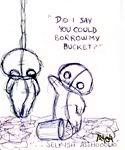TTTEscrima,
I realize now that you're either a kid or a troubled person. You couldn't possibly be an adult, because that would indicate behavior patterns typical of pyschosis including: hallucinations about your kung-fu theories, delusions about MMA people attacking you, and a thought disorder that prevents you from making constructive statements.
Therefore, please find help somewhere else as I'm not a certified psychologist. I failed to realize it before, but you've been using my threads as therapy in the form of baseless attacks.
Since I really am of no help to you, I'll agree to disagree with you. Again, please find help...
I realize now that you're either a kid or a troubled person. You couldn't possibly be an adult, because that would indicate behavior patterns typical of pyschosis including: hallucinations about your kung-fu theories, delusions about MMA people attacking you, and a thought disorder that prevents you from making constructive statements.
Therefore, please find help somewhere else as I'm not a certified psychologist. I failed to realize it before, but you've been using my threads as therapy in the form of baseless attacks.
Since I really am of no help to you, I'll agree to disagree with you. Again, please find help...


 If you are old enough to remember the things that have happened and the footage that made it out and you check the official stories they vary greatly to say the least.
If you are old enough to remember the things that have happened and the footage that made it out and you check the official stories they vary greatly to say the least.

Comment